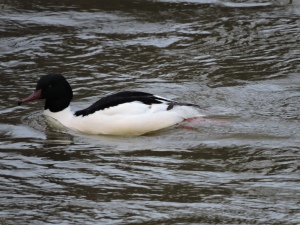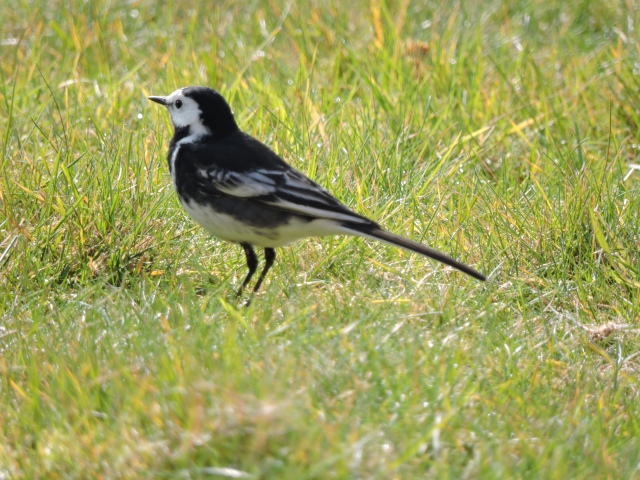Birds are one of the great delights of living at Ruskin Land. They bring the place to life and it has been wonderful to discover just how many different species live around us.

Goosander on the Severn
Earlier this month we had a few friends to stay one of whom is a keen twitcher (and who has provided some superb photos for this blog – thanks Ben!). On a short walk down to Dowles Brook and along the River Severn into Bewdley we saw 37 species and heard but didn’t see ravens, a mistle thrush and numerous Tawny Owls. On that occasion we also failed to spot the enchanting dipper which inhabits stretches of the banks of the Dowles but we did see some Grey Wagtails who can be frequently seen alongside them. A few days later I counted 17 species on and around the bird feeder just outside our kitchen window, including siskins, coal tits and goldfinches. My favourites are the pair of nuthatches that regularly visit and display their impressive climbing skills. Our grandchildren are most impressed by the Great Spotted Woodpecker who comes for brunch most days.
I have written here before about the efforts to encourage ground nesting birds in the Wyre Forest. Many bird species have been in steep decline in recent decades. A total of 98 species have been recorded in the Wyre area during the breeding season over a 21 year period. The national breeding woodland bird index, an overall measure of bird populations, has declined by over 20% between 1970 and 2014.
It is hard to imagine how much more abundant the birdlife would have been fifty years ago. While some species have become more prevalent, many more species, such as the wood warbler and willow tit, have seen population declines of 25% or more. Studies point to changing woodland structure such as closed high canopies combined with deer grazing causing a loss of low vegetation which is so important for many bird species.
Creating a more diverse woodland structure is at the heart of the management plans being developed by the Wyre Community Land Trust. This should help provide more extensive habitats and sources of food for a range of less common species still present in the Wyre such as hawfinches, redstarts, woodcock – our only woodland wading bird – and the wood warbler. Controlling the size of the deer population, though sometimes controversial, also has an important part to play in encouraging more dense low vegetation. Keeping dogs on leads particularly during the nesting season can also help reduce disturbance. The restoration of heathland sites, of which there are a few near Ruskin Land, might even entice the magical nightjar to return to the Wyre.

Pied wagtail in the orchard
When arrived at St George’s Farm last July we were obviously not the first to move into the farmhouse. Earlier in the year, house martins had built numerous nests under the eaves of the roof and, together with swallows, they provided wonderful aerial displays as they foraged over the neighbouring fields for food. Ruskin Land became a much quieter place when they left for warmer climes towards the end of the Summer. While there has been plenty of avian activity in recent weeks, we’re eagerly anticipating the return of the swallows and martins this Spring.







Thanks for the info. I really enjoy reading your blogs Happy Easter Yvonne
Sent from my iPad
>
LikeLike
That’s great Yvonne. Hope you’ve had a lovely weekend. Neil
LikeLike
Hi. Lynne and Neil,
Thank,you for the blog great pictures. Hope you had a good weekend,
Love ️Mum XXX
Sent from my iPad
>
LikeLike
Dear Neil
Delighted to read this. I must look out for some of those rarer species when I am next there.
A query. When you say that the national woodland bird breeding index has declined by 20%, does that mean that the 98 species recorded are 20% fewer than they would have been, or does Wyre host an above-average number?
All good things
Clive
LikeLike
Thanks Clive. The national index is an overall measure that covers the whole country as I understand it. I don’t think this can simply be applied to the situation in the Wyre Forest as there will be a lot of variation from place to place but we do know that birds once present here are now either absent or far less common such as the nighjar, hawfinch and woodcock. Having said that, the Wyre Forest is still relatively rich in birdlife. Hope that helps. I should perhaps make the blog clearer. All the best, Neil
LikeLike